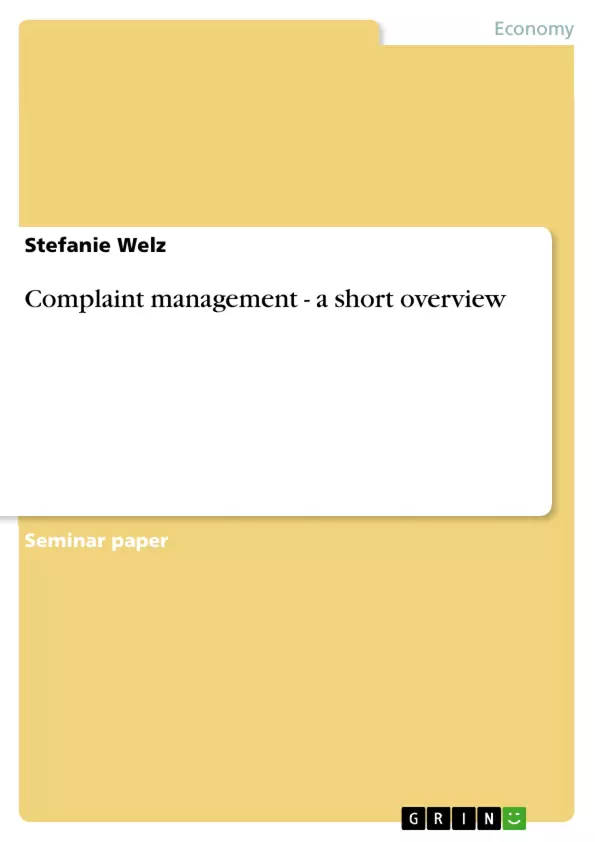1 Introduction
1.1 Executive Summary
In the past years the stress of competition towards companies is growing. In addition, companies can hardly grow or make profit in the long run due to stagnant or shrinking markets and increasing internationalisation. Continuous improvement or enhancements of production technology and the products themselves lead to the fact that products are even more substituted. Thus, it is not sufficient to sell only good products but the service is coming more to the fore from customer’s point of view.
This change in general conditions leads to a focusing on customer orientation. While the acquisition of new customers was formerly relevant, today’s instruments regarding the customer retention gain more importance. Companies recognized that satisfied customers considerably contribute to corporate success. Empirical studies showed that it is five times more expensive to acquire a new customer and considerably cost extensive to recover a lost customer than binding existing customers.1
Dissatisfied customers change to competition or harm the company via negative word-ofmouth propaganda. Permanent customer relations in comparison do have a profit- as well as cost-advantage. Customer retention leads to more profit due to the buying frequency, crossselling- effects and cost savings in consequence of saved acquisition costs and efficiency advantages. Further chances result from the decreasing price sensitivity of the customer. Beside of the direct profit impacts of customer retention, indirect impacts on further customer relations occur, e.g. recommendations of satisfied customers. The corporate objective should be the focusing on customer retention and thus to improve the corporate competitive position.
Inhaltsverzeichnis (Table of Contents)
- Introduction
- Executive Summary
- Scope of Work
- Problem and Research
- Problem Definition
- Relevance and Motivation
- Methodology
- Basics of complaint management
- General classification into customer management
- Objectives of complaint management
- Development and effects of customer dissatisfaction
- Complaint management as an instrument for customer retention
- Complaint stimulation
- Complaint acceptance and processing
- Complaint reaction
- Complaint analysis, - controlling, - reporting, -utilization
- Bibliography
- Literature
- Appendix
- ITM Checklist
- Conclusion, critical comments and outlook
Zielsetzung und Themenschwerpunkte (Objectives and Key Themes)
This assignment explores the significance of complaint management as a crucial tool for achieving customer retention and overall business success. It examines the evolving market landscape, where customer satisfaction and retention have become paramount, and analyzes the role of complaint management in building lasting customer relationships.
- The importance of customer retention in today's competitive market
- The relationship between customer dissatisfaction, complaints, and customer retention
- The development and effects of customer dissatisfaction
- The implementation and management of complaint management systems
- The strategic benefits of complaint management for achieving corporate success
Zusammenfassung der Kapitel (Chapter Summaries)
The introduction provides a succinct overview of the growing importance of customer retention in an increasingly competitive business environment. It emphasizes the need for effective strategies to build and maintain customer loyalty, highlighting the role of complaint management in this context.
Chapter two delves into the problem definition, outlining the changing market conditions and the growing emphasis on customer orientation. It highlights the relevance of complaint management as a key instrument for fostering customer relationships and creating long-term value for the company. This chapter also introduces the objectives of the assignment and the methodology employed.
Chapter three focuses on the fundamentals of complaint management, exploring its classification within the broader context of customer management. It examines the various objectives of complaint management, analyzing the development and effects of customer dissatisfaction, and highlighting the link between complaint satisfaction and customer retention.
Chapter four delves into the practical application of complaint management as a tool for achieving customer retention. It analyzes the various stages of the complaint process, including complaint stimulation, acceptance, processing, and reaction. This chapter also explores the importance of complaint analysis, controlling, and reporting for understanding customer needs and optimizing future interactions.
Schlüsselwörter (Keywords)
Key terms and concepts explored in this assignment include customer retention, customer relationship management (CRM), complaint management, customer satisfaction, customer dissatisfaction, customer behaviour, market conditions, competitive advantage, business success, and strategic management.
- Citation du texte
- Stefanie Welz (Auteur), 2006, Complaint management - a short overview, Munich, GRIN Verlag, https://www.grin.com/document/73462



